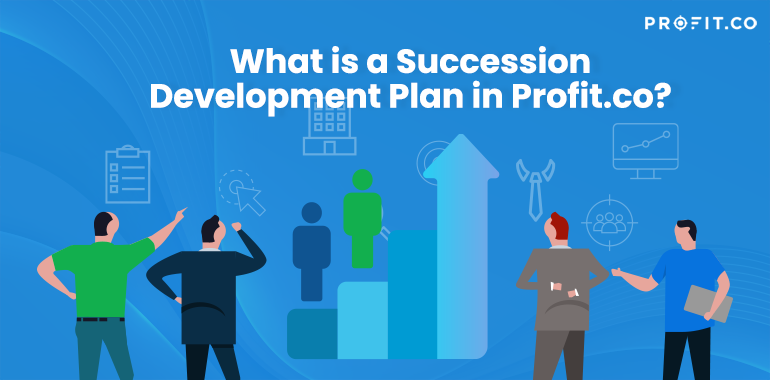“You can’t connect the dots looking forward; you can only connect them looking backwards.”
Understanding Succession Development Plan
Succession and Development play a pivotal role in facilitating the advancement and growth of individuals within an organization. Through the Succession and Development framework, organizations can create tailored programs for their workforce, including Individual Development Plans, Performance Improvement Plans, and Potential Assessments. This approach provides a structured pathway for employee progression, fostering professional development and enhancing organizational contributions.
Understanding the history of your company, much like appreciating world history, enables leaders to glean valuable lessons from previous missteps and successes. This historical insight, combined with a clear understanding of the company’s present state and future direction, provides leaders with the necessary tools to craft a comprehensive guide. Such a guide is crucial for employees undergoing various transitions: it supports those departing, integrates new members joining the team, and assists top performers in navigating their ascent up the corporate hierarchy. This holistic approach ensures that the company’s past, present, and future journey informs and shapes its strategic planning and workforce development.
To experience how Profit.co can transform your Succession Development Planning process!
The Evolution of Succession Planning
Executive leaders are often tasked with planning succession for their teams and participating in organization-wide efforts. According to Gartner’s research on succession planning, Traditionally, organizations have used a pipeline management approach, focusing on current leadership roles and grooming successors within each unit until ready for transition. However, as roles evolve faster, this method’s effectiveness diminishes, especially when scaled up, often leading to process-focused rather than strategic planning.
To address these challenges, organizations are shifting towards a portfolio management strategy. This involves prioritizing critical roles aligned with future strategy, broadly identifying successors across the organization, and diversifying successor options for various potential scenarios. This strategy allows for more focused planning on key roles, enhancing the overall capacity of the leadership bench to adapt as roles change. Here are the major differences between pipeline management and portfolio management.
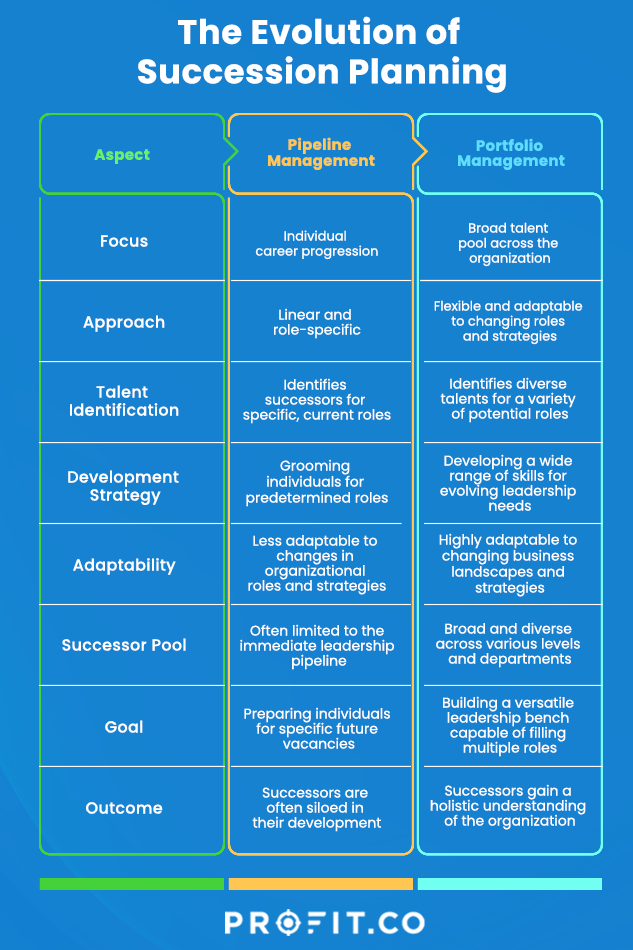
With this context in mind, let’s explore some effective strategies to construct and enhance your portfolio management approach.
Effective Strategies for Succession Planning
The goal of succession planning is to create a culture of ongoing learning and preparedness in an organization, not just to fill vacant positions. It involves finding and developing internal talent for key roles to maintain business operations, avoid hiring risks, and motivate employees with clear career opportunities.
In the present scenario, potential leaders must be selected based on their performance, skills, and alignment with the company’s vision. However, according to research, it is said that only half of companies (50%) have written down the skills required for the next CEO (Stanford, 2010). The companies should make sure that the C-suite leaders receive customized development plans, which include training, mentoring, and challenging assignments to prepare them and their employees for future roles, with their progress monitored on the platform. Continuous feedback is an essential part of this plan, using tools for regular communication, evaluation, and 360 feedback to keep potential successors involved and aware of their strengths and weaknesses.
The plan’s effectiveness is evaluated by how ready potential leaders are for new roles, how well they perform in those roles, and how they contribute to business continuity and growth. Moreover, developing future leaders in line with the company’s culture, values, ethics, and mission is vital, ensuring that the leadership development process is closely linked with the organization’s identity.
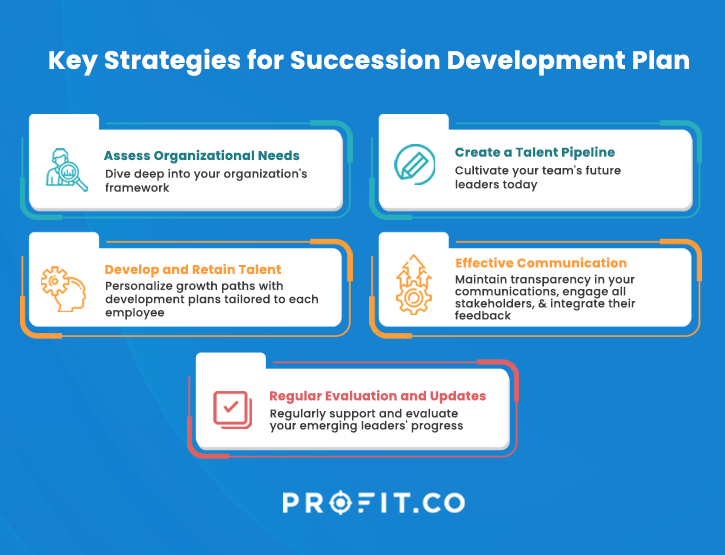
Here are some effective strategies for succession planning:
Assess the current and future needs of the organization
Identify the critical and vulnerable positions that are essential for the success of the business and the skills and competencies required for those roles. Use data and analytics to support your decisions and get buy-in from senior leaders.
Create a talent pipeline
Evaluate the current performance and potential of your employees, and nominate successors from the qualified positions. Use various methods, such as assessments, feedback, interviews, and simulations, to measure their readiness and suitability for the target roles.
Develop and retain your talent
Provide your successors with individualized development plans that address their strengths and areas for improvement. Offer them opportunities to gain experience and exposure to different aspects of the business, such as mentoring, coaching, job rotation, shadowing, and training.
Communicate your succession plans effectively
Establish who needs to know what and when, and tailor your communication accordingly. Be transparent and timely with your communication, and avoid creating unrealistic expectations or confusion. Engage your successors and stakeholders in the process, and solicit their feedback and input.
Evaluate and update your succession plans regularly
Monitor the progress and performance of your successors, and provide them with ongoing support and feedback. Review and revise your succession plans as needed, based on the changing needs of the organization and the availability of talent. Celebrate the achievements and milestones of your succession planning efforts.
Simon Sinek insightfully notes that “If you hire people just because they can do a job, they’ll work for your money. But if you hire people who believe what you believe, they’ll work for you with blood, sweat, and tears.” This principle aligns with the understanding that while every employee seeks a livelihood, there’s a profound distinction between those who are merely present for financial reasons and those deeply connected with their organization’s mission. Such alignment not only inspires exceptional commitment but is also crucial in succession planning. Recognizing future staffing needs and identifying individuals with the requisite skills and potential for future roles is essential. Utilizing tools like the Professional & Organizational Development’s Succession Planning Toolkit, and engaging HR professionals in this process, can effectively guide in nurturing and preparing employees who are not just competent but also passionately aligned with the organizational ethos.
Succession Development Plan in Profit.co
Profit.co’s Succession and Development module stands out as a comprehensive and versatile tool designed to streamline and enhance employee development within organizations. This feature serves as a unified interface that enables users to create and customize a variety of developmental frameworks efficiently. It allows for the design of tailored layouts specifically for Individual Development Plans (IDP), Performance Improvement Plans (PIP), Succession Development Plans (SDP), and Potential Assessments.
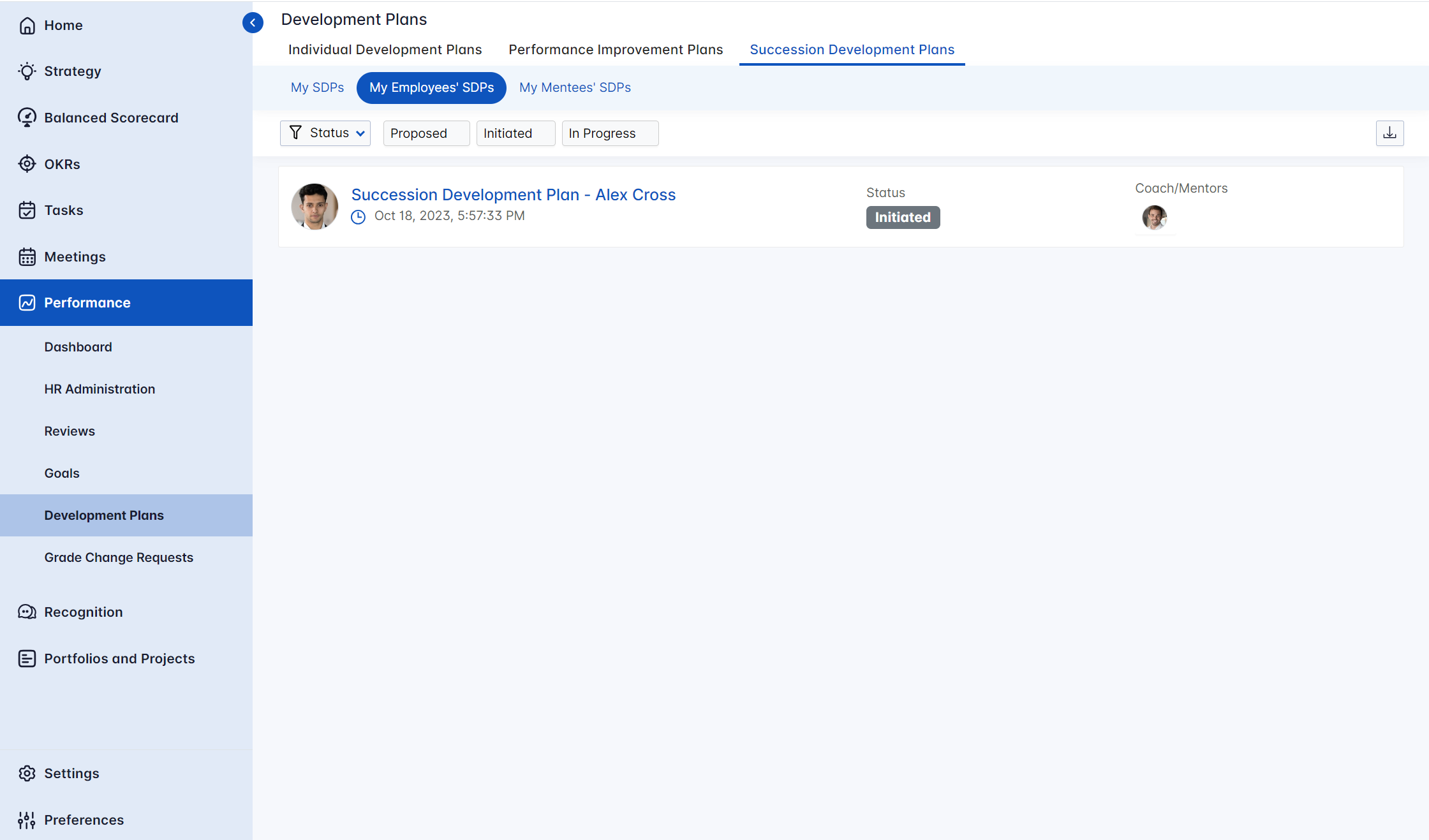
One of the key strengths of this module is its ability to provide organized and specific plan categories for both IDP and PIP. This organizational capability ensures that each development plan is tailored to meet the unique needs and goals of individual employees. Furthermore, the module offers enhanced performance assessment tools like the 9 Box Matrix which is used to evaluate and plot the organization’s talent pool that displays the organization’s high and low performers in a visual dashboard that enables users to identify and improve talents.
Your succession planning should yield development goals for prospective successors. Observe Amelia Ann’s progress from her current to a future role, highlighted by goal-oriented activities. This tracking allows her coach/mentor to assess her growth, providing insights into how she handles new challenges and aiding in planning for future leadership transitions.
At Profit.co, we understand the importance of identifying skill gaps in employees earmarked as successors. Addressing these gaps promotes growth in crucial areas, ensuring your business remains uninterrupted even amidst leadership changes.
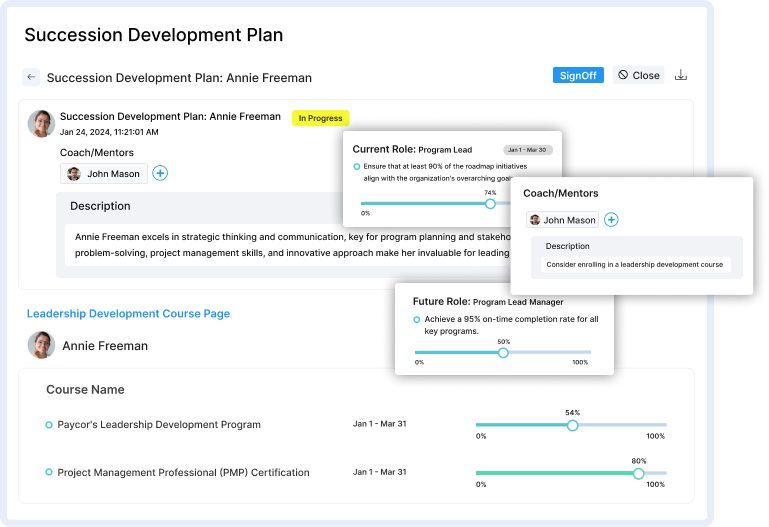
3 Key advantages of this feature
To seamlessly integrate an effective succession planning plan into your system, it’s important to understand the unique approach taken by Profit.co. This involves a distinct methodology that sets it apart in ensuring smooth transitions and maintaining organizational stability.
1. Centralized customization
Users can efficiently tailor layouts for Individual Development Plans, Performance Improvement Plans, and Potential Assessments, all from a singular, user-friendly window.
Scenario : Imagine a company, ABC Corp, implementing Profit.co’s system. The HR manager, Sarah, needs to update Individual Development Plans (IDPs) for her team. Instead of navigating through multiple platforms or interfaces, she uses Profit.co’s centralized customization feature. Here, Sarah can easily access and modify layouts for IDPs, Performance Improvement Plans (PIPs), and Potential Assessments all in one place. This streamlined process saves her time and reduces the complexity of managing different development tools.
2. Flexible planning
The tool enables the creation of specific plan categories for both IDP and PIP, providing a structured approach to employee development.
Scenario: Let’s say that, In XYZ Enterprises, the HR department wants to create distinct development pathways for their sales team (IDP) and their customer service team (PIP). Using Profit.co, they can craft specific plan categories for each team. For the sales team, they focus on skills like market analysis and client engagement, whereas the customer service team, the focus is on conflict resolution and communication skills. This flexibility allows the company to address the unique development needs of different teams, enhancing their overall effectiveness.
3. Enhanced assessment capabilities
Users can formulate new potential questions and ratings, offering a more nuanced and tailored assessment process.
Scenario: Consider a tech firm, TechGenix, which prides itself on its innovative culture. To maintain this, they need a nuanced understanding of their employees’ potential. With Profit.co’s enhanced assessment capabilities, the HR team at TechGenix can formulate new, tailored potential questions and ratings. For instance, they create specific questions to assess an employee’s ability to innovate and adapt to new technologies. This customized assessment process helps them identify and nurture the talent that will drive their future growth.
The Importance of a Structured Approach
The effectiveness of a Succession Development Plan on an Objective and Key Results (OKR)-driven platform such as Profit.co hinges on its ability to be structured and quantifiable. It is not enough to simply identify potential leaders; establishing a clearly defined strategy for their development is essential. According to Deloitte in 2014, 86% of leaders regard succession planning as an “urgent” and “important” priority, yet a mere 13% are confident in their execution of such plans. To enhance succession planning, strategic planning is crucial. This involves various components, including targeted training, mentorship programs, and providing access to challenging projects, all aimed at creating an environment conducive to the growth and skill enhancement of future leaders. The goal is to ensure these emerging leaders are well-equipped and ready for a seamless transition into their new roles when the opportunity presents itself.
However, it’s essential to recognize that this plan is not static. It must be inherently dynamic, and capable of adapting to the evolving needs of the business and the individuals it aims to develop. To maintain its relevance and effectiveness, the plan requires regular feedback, performance evaluations, and necessary adjustments. This process is not a one-time event but a continuous cycle. It demands consistent assessment and refinement to stay aligned with the individual’s career progression and the company’s strategic goals.
Central to this approach is the emphasis on a continuous feedback loop and the need for regular updates. This ensures that the succession development plan is not just created and left to operate independently; rather, it’s an evolving strategy that integrates feedback from various sources. Performance is regularly evaluated, and the plan is updated to incorporate new insights, respond to changes in the business landscape, or adapt to shifts in strategic direction. This ongoing process of evaluation and adjustment is what makes the plan both robust and adaptable, ensuring it remains effective in preparing future leaders for their roles in an ever-changing business environment.
To make this approach more viable, let’s consider a real-life example, TechNova Corporation, a mid-sized cybersecurity firm, significantly benefited from a structured approach to its Succession Development Plan, aimed at nurturing internal talent for leadership roles. The company identified high-potential employees in various departments and engaged them in targeted training programs to enhance their leadership, strategic thinking, and technical skills. In parallel, a mentorship program paired these promising individuals with experienced executives, offering deep insights into the company’s decision-making and culture. TechNova further provided these candidates with opportunities to lead challenging projects, offering both a testbed for their skills and visibility to upper management.
Integral to this approach was a continuous feedback loop, allowing regular performance assessments and necessary adjustments to the development plan. This strategy paid off within two years, as TechNova successfully filled two senior management positions from this talent pool, enhancing continuity and stability. This success not only boosted employee morale and retention, demonstrating the company’s commitment to its workforce but also established TechNova as a forward-thinking organization, fostering a culture of growth and setting a benchmark for sustainable success in the tech industry.
Integration with OKRs and Performance Management
Profit.co integrates succession planning with its core functionalities like OKRs and performance management. This integration allows for a seamless approach where the development of potential leaders is aligned with the company’s objectives and performance metrics. It ensures that the development plan is not in isolation but is a part of the overall strategic goals of the organization.
With a comprehensive tool like Profit.co, where data-driven decision-making is key, integrating succession planning with the OKR framework is a natural fit. This integration allows for the creation of clear, measurable key results specifically tailored to succession planning. It’s about setting tangible goals for leadership development, aligning them with the company’s broader objectives, and ensuring that these goals are realistic, achievable, and impactful.
Measuring Succession Development Plans with KPIs
To effectively measure the success of Succession Development Plans (SDPs), organizations can introduce specific Key Performance Indicators (KPIs) that reflect the effectiveness of these plans. These KPIs provide quantifiable metrics that allow an organization to evaluate the progress and impact of its succession strategies. Some of the critical KPIs to consider include:
Leadership Succession Rate
This KPI tracks the percentage of leadership positions filled internally versus external hiring. A higher internal succession rate indicates a more effective SDP, as it demonstrates the plan’s success in preparing internal candidates for leadership roles.
Employee Retention Rate Post-Succession
Monitoring retention rates, especially among those who have been part of the succession plan, is crucial. High retention rates post-succession imply that the plan is effective in satisfying the career aspirations of employees, contributing to a lower turnover.
Time to Competency
This metric measures the time it takes for newly promoted leaders to reach full proficiency in their new roles. A shorter time to competency suggests that the SDP is successful in preparing candidates adequately for their new responsibilities.
360-Degree Feedback Scores
Incorporating feedback from a variety of sources (peers, subordinates, superiors) about the performance of individuals who have moved into new roles can provide insights into their leadership effectiveness and the overall impact of the SDP.
Successor Readiness Index
This KPI evaluates how prepared successors feel and are perceived to be for their new roles. It can include assessments of skill levels, confidence, and performance in preparatory roles or assignments.
By regularly monitoring these KPIs, organizations can gain valuable insights into the effectiveness of their Succession Development Plans. Adjustments and refinements to the plan can be made based on this data, ensuring that the SDP remains aligned with the organization’s evolving needs and continues to effectively develop future leaders.
Final Thoughts
In conclusion, the evolving nature of the workplace, driven by the advent of the knowledge worker era and digital innovation, necessitates reevaluating succession planning strategies. In today’s environment, where soft skills increasingly outweigh hard skills and recruitment and talent development methods have transformed, companies must adapt. This shift includes recognizing and addressing talent gaps that often stem from historical hiring and development practice patterns. The changing landscape also affects management structures, with digital tools enabling more efficient training methods, such as online team training.
To effectively align with these changes, companies should view succession planning as an opportunity to revamp their delivery and development structures, keeping in mind their goals for the next three to five years. This forward-thinking approach involves envisioning the desired future state of the company and the individual roles within it, and then strategically planning backwards from that future state.
Also, in the future, the SDP plans must focus on regularly analyzing emerging trends and technologies in the industry to anticipate future roles and competencies. This involves staying informed about market shifts, technological advancements, and evolving business models. Utilizing predictive analytics to identify potential future skill gaps and roles. While current platforms might not support this entirely, acknowledging the importance of data-driven insights in the future succession planning processes is crucial. One more idea would be, proactively creating a pipeline of talent that is diverse and has a broad skillset. This approach ensures that the organization has a pool of candidates ready to step into newly emerging roles.
By doing so, organizations can ensure they are not only prepared for the changes that the digital age brings but are also positioned to thrive in this dynamic environment.
Ready to build a robust Succession Development Plan? Explore Profit.co’s tools today
Related Articles
-
5 Essential Dashboards Every Business Leader Should Use
Business leaders, are you steering your strategy with crystal-clear insights—or flying blind? Profit.co's dashboards are designed to make your decisions... Read more
-
What is a Balanced Scorecard?
When it comes to gauging an organization's health, the financial bottom line is often the go-to metric. But what if... Read more
-
Why Does Your Organization Need an Individual Development Plan (IDP) to Grow?
Introduction If you want to stay up to date on the job market, tackle the demands of today’s workplace, and... Read more
-
Performance Competencies in Profit.co: Uses, Levels, & Examples
Evaluating Performance Performance management is one of the key pillars of a successful organization. Delivering useful feedback to employees and... Read more
